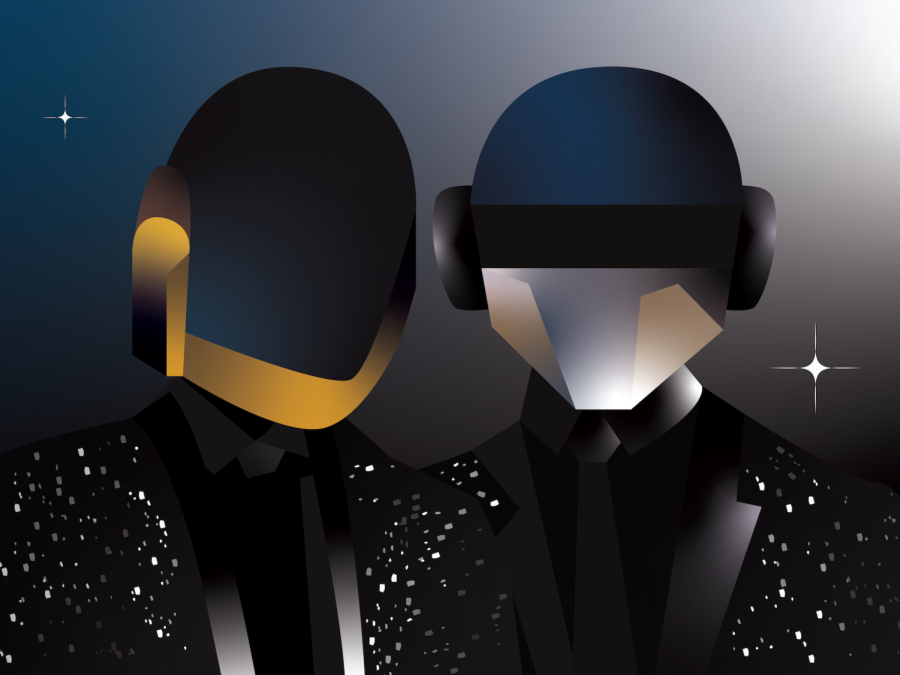Daft Punk: Robot rock for the world
Daft Punk’s debut album “Homework” recently celebrated its 25th anniversary. We revisited the legacy of the famous DJ duo.
French DJ duo Daft Punk, who announced their retirement last year, recently remastered and re-released their debut studio album, “Homework,” on the 25th anniversary of its release. This new edition offers a chance to revisit the legacy of their influence on electronic music. (Staff Illustration by Susan Behrends Valenzuela)
February 28, 2022
Last year, Daft Punk released a video of themselves self-destructing to announce their retirement. This year marks the 25th anniversary of their debut album, “Homework.”
Electronic music, as we know it today, came to be in 1997 with Daft Punk’s “Homework.” With their debut album, the DJ duo composed of two French teenagers — Thomas Bangalter and Guy-Manuel de Homem-Christo — redefined what pop music could be by creating an album informed by their love of disco and rave culture. “Homework” blends the metallic thuds that defined European rave culture over the course of the 1990s with the infectious grooves of old disco records the two teens had collected over the years. The result, remastered this week and re-released as “Homework (25th Anniversary Edition),” is a musical wonder designed to inspire non-stop dancing — a perfect calibration of heavy bass-lines accompanied by spun-out melodies that suck you into a world of mechanized sound.
Let’s begin with the title: “Homework.” In a 1997 interview with POP Magazine, Bangalter stated the title came about because the album was recorded in his bedroom, explaining, “you always do your homework in the bedroom.” “Homework” is the work of two DJs who are just getting started, exhibiting the free-flowing experimentation you’d expect from two students of music looking to do something new and working against the rules of a common assignment. There’s a quality of learning and devotion to the album, pinning it as the work of two tinkerers with a great respect for music. It’s for this reason that “Homework” remains Daft Punk’s most fun and energetic album to date, with its infectious and intoxicating throughline of invigorating rave tracks that continuously up the ante when it comes to what can be done with a couple of loopers and enough time in a bedroom.
Given the fact that “Homework” was produced in a calm, domestic environment, how perfectly it works as a rave set for a bulk of dancing bodies is absolutely shocking. Their “Alive 1997” set is evidence of this fact, with its shriek-electronica, perfect transitions and pounding bass, demonstrating how Daft Punk transcended the death of disco and got generations to dance to their tunes by resuscitating disco’s popularity as a new sonic beast: a mish-mash of genres ranging from punk to U.K. garage.
“We make dance music with a rock’n’roll attitude,” Bangalter said in a 1995 interview with POP Magazine. Growing up listening to everything from The Beach Boys to My Bloody Valentine, there’s a verve to Daft Punk’s work. “Homework” is an early blueprint of that spirit, mixing and mashing music of all sorts to develop a delightful trance that feels like the perfect algorithmic condensation of rhythms from the past, present, future and all regions of the world.
“Around the World,” which marks the midpoint of “Homework,” evokes this drive to develop a universal sound to induce listeners worldwide to dance. “We just want our music to spread to as many people as possible,” said Bangalter in the 1995 interview.
Twenty-five years after the release of “Homework,” it’s clear Daft Punk’s music has reached all corners of the globe. After releasing their rave-based debut back in 1997, Daft Punk would go on to work with a variety of artists ranging from Kanye West to Julian Casablancas from The Strokes, accruing several Grammy wins along the way.
Daft Punk quickly became the reference for everything innovative in music, constantly defying genre conventions by adopting a syncretic electronic style. The duo also overturned what could be done in terms of staging with their Alive 2006/2007 live tour, for which they built a pyramid structure for concert venues with which they would project aggressive light shows to accompany their concert, hearkening back to their early days as rave DJs in France. The recent release of Daft Punk’s concert film from that same era which accompanied the re-release of “Homework” demonstrates how they were able to build upon their set over the years, as a simple projector set-up went on to become a massive choreography of strobe lights and pulsating visuals. Despite cloaking themselves in the persona of robots, the duo came to represent the most lively music on the planet.
“Homework” exhibits that brimming genius at its point of origin. Songs like “Da Funk” infuse the sounds of the city atop a G-Funk beat because every sound the world contains is a functional melody in the minds of Daft Punk. “Rollin’ & Scratchin’” is a hard, thumping piece of industrial techno, and it’s followed by “Teachers,” an homage to the duo’s funk idols. In any other band’s hands, such a juxtaposition would have been an absolute failure, but Daft Punk’s ingenuity allowed them to see a historical commonality across music that they often boiled down to a 4/4 rhythm and twisted in every possible sonic direction.
More than robots, they acted like wizards, conjuring up new sounds by throwing their best samples into a cauldron that spit back novel concoctions. There’s a magic to their mixing, a magic that informed the myth that would build around them for years to come, inspiring Pharrell Williams’ theory that they are actually aliens and a whole website dedicated to documenting their careers.
“Homework” meant something new at the turn of the millennium, signaling how pop music could be punk, techno, funk and disco all at the same time, thanks to the new technologies musicians had at their disposal. As the pioneers of a new form of electronic music, Daft Punk’s “Homework” represents a manifesto laying out every potential future for pop music in decades to come. Daft Punk understood new generations needed music that hopped between genres and embraced diversity, developing a sound of sundries that would inspire everyone who picked up “Homework” from their local record shop and listened to its entrancing 75-minute musical maelstrom.
Contact Nicolas Pedrero-Setzer at [email protected].

























































































































































